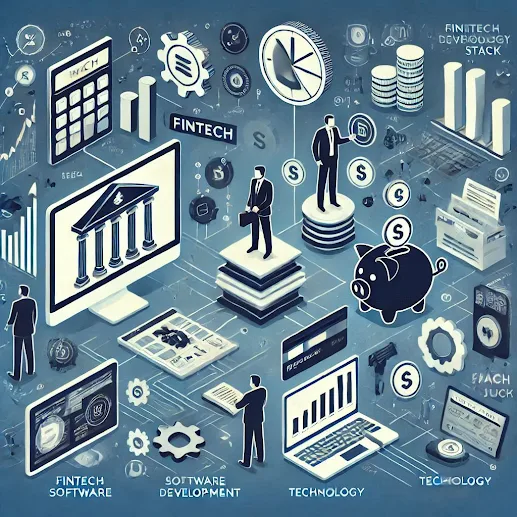The FinTech industry has transformed the financial services landscape, offering innovative solutions that enhance efficiency, security, and accessibility. With the global FinTech market projected to grow at a CAGR of 23.58% from 2021 to 2025, understanding the nuances of FinTech software development is more crucial than ever. This guide delves into the intricacies of FinTech software development, exploring its types, benefits, challenges, and the technologies driving this sector forward.
Why Does FinTech Matter?
The Importance of FinTech in Modern Financial Services
FinTech (Financial Technology) has become the backbone of the modern financial ecosystem. By leveraging advanced technologies, FinTech enables seamless transactions, better risk management, and enhanced customer experiences.
Key Statistics:
The global FinTech market is expected to reach $698.48 billion by 2030.
Digital payment solutions account for over 25% of all FinTech revenues worldwide.
Over 64% of consumers have adopted FinTech services, a significant rise from 33% in 2017.
FinTech’s relevance is evident across industries, from banking and insurance to wealth management and lending. It addresses critical challenges like reducing transaction times, enhancing transparency, and improving financial inclusion.
What is Financial Software Development?
Defining Financial Software Development
Financial software development involves designing, building, and maintaining software solutions tailored to financial operations. These solutions cater to various needs, including payment processing, fraud detection, customer management, and regulatory compliance.
Financial software development underpins FinTech innovations, enabling the creation of digital wallets, peer-to-peer lending platforms, and advanced trading algorithms.
Example Use Cases:
Automated trading platforms use AI to analyze market trends and execute trades.
Loan management systems streamline credit evaluation processes.
Types of FinTech Software Development
FinTech software spans multiple categories, each addressing specific aspects of the financial ecosystem:
1. Banking Software
Features: Core banking systems, mobile banking apps, and online banking platforms.
Example: JPMorgan Chase’s app for real-time transaction tracking.
2. Payment Gateways
Features: Secure and efficient online transaction processing.
Example: PayPal processes over 41 million transactions daily.
3. Wealth Management Platforms
Features: Robo-advisors and investment tracking tools.
Example: Betterment, with over $33 billion in assets under management.
4. Insurance Software (InsurTech)
Features: Policy management, risk assessment, and claims automation.
Example: Lemonade, an AI-driven insurance platform.
5. Cryptocurrency and Blockchain Applications
Features: Crypto wallets, decentralized exchanges, and blockchain payment systems.
Example: Binance processes over $76 billion in daily crypto transactions.
A Step-by-Step Guide to FinTech Software Development
1. Market Research and Requirements Gathering
Analyze market needs and define project scope.
Identify target audience pain points and regulatory requirements.
2. Designing User-Centric Interfaces
Create intuitive UI/UX designs to enhance user engagement.
Focus on accessibility and responsive design.
3. Choosing the Right Technology Stack
Select tools and frameworks based on scalability and security needs.
Common choices: Python, React, PostgreSQL, and AWS.
4. Development and Integration
Build the backend and frontend components.
Integrate third-party APIs for payment gateways and KYC/AML.
5. Testing and Compliance Checks
Conduct functional, performance, and security testing.
Ensure adherence to regulations like GDPR and PCI DSS.
6. Launch and Post-Deployment Support
Deploy the software on cloud infrastructure.
Monitor performance and provide ongoing maintenance.
Pros and Cons of FinTech Software Development
Pros:
Enhanced Efficiency: Automation reduces manual effort and errors.
Improved Customer Experience: Real-time updates and personalized services.
Scalability: Cloud-based solutions accommodate growing user bases.
Cons:
Regulatory Hurdles: Navigating global compliance standards is challenging.
High Initial Costs: Development and deployment require significant investment.
Cybersecurity Risks: Financial data breaches can have severe repercussions.
Technology Stack for FinTech Software Development
Backend Development:
Languages: Python, Java, Node.js.
Frameworks: Django, Spring Boot.
Frontend Development:
Libraries: React, Angular.
Tools: Bootstrap, Tailwind CSS.
Databases:
Relational: MySQL, PostgreSQL.
NoSQL: MongoDB, Redis.
Security Tools:
Encryption: AES-256.
Authentication: OAuth, JWT.
Cloud Services:
AWS, Microsoft Azure, Google Cloud Platform.
FinTech Software Industry Market Overview and Trends
Market Overview
The FinTech industry is growing rapidly, driven by increasing smartphone penetration and demand for digital financial services.
Key Trends:
AI and ML: Automating fraud detection and improving credit scoring models.
Blockchain: Enhancing transparency and reducing transaction costs.
Open Banking: Enabling secure data sharing between financial institutions.
Embedded Finance: Integrating financial services within non-financial platforms.
To Wrap Up!
FinTech software development is at the forefront of transforming the financial industry, offering innovative solutions to meet dynamic market needs. By leveraging cutting-edge technologies and adhering to regulatory standards, businesses can create scalable and secure FinTech applications that drive growth and improve customer experiences.
Frequently Asked Questions
1. What is the cost of developing a FinTech application?
The cost ranges from $50,000 to $500,000, depending on complexity, features, and technology stack.
2. How long does it take to develop a FinTech solution?
Development timelines range from 6 months to 18 months, based on the scope and requirements.
3. What are the key compliance requirements for FinTech software?
Compliance standards include GDPR, PCI DSS, and local financial regulations specific to operating regions.


.png)
.png)





No comments:
Post a Comment
Thanks For Your Feedback